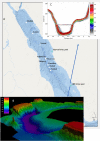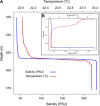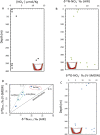Discovery of Afifi, the shallowest and southernmost brine pool reported in the Red Sea
- PMID: 31969577
- PMCID: PMC6976674
- DOI: 10.1038/s41598-020-57416-w
Discovery of Afifi, the shallowest and southernmost brine pool reported in the Red Sea
Abstract
The previously uncharted Afifi brine pool was discovered in the eastern shelf of the southern Red Sea. It is the shallowest brine basin yet reported in the Red Sea (depth range: 353.0 to 400.5 m). It presents a highly saline (228 g/L), thalassohaline, cold (23.3 °C), anoxic brine, inhabited by the bacterial classes KB1, Bacteroidia and Clostridia and the archaeal classes Methanobacteria and Deep Sea Euryarcheota Group. Functional assignments deduced from the taxonomy indicate methanogenesis and sulfur respiration to be important metabolic processes in this environment. The Afifi brine was remarkably enriched in dissolved inorganic carbon due to microbial respiration and in dissolved nitrogen, derived from anammox processes and denitrification, according to high δ15N values (+6.88‰, AIR). The Afifi brine show a linear increase in δ18O and δD relative to seawater that differs from the others Red Sea brine pools, indicating a non-hydrothermal origin, compatible with enrichment in evaporitic environments. Afifi brine was probably formed by venting of fossil connate waters from the evaporitic sediments beneath the seafloor, with a possible contribution from the dehydration of gypsum to anhydrite. Such origin is unique among the known Red Sea brine pools.
Conflict of interest statement
The authors declare no competing interests.
Figures









References
-
- Cita MB. Exhumation of Messinian evaporites in the deep-sea and creation of deep anoxic brine-filled collapsed basins. Sediment. Geol. 2006;188–189:357–378. doi: 10.1016/j.sedgeo.2006.03.013. - DOI
-
- Augustin, N., Devey, C. W. & van der Zwan, F. M. A modern view on the red sea rift: tectonics, volcanism and salt blankets. In: Geological Setting, Palaeoenvironment and Archaeology of the Red Sea (eds Rasul, N. & Stewart, I.) 37–52 (Springer International Publishing, 2019).
-
- Campbell KA. Hydrocarbon seep and hydrothermal vent paleoenvironments and paleontology: Past developments and future research directions. Palaeogeogr. Palaeoclimatol. Palaeoecol. 2006;232:362–407. doi: 10.1016/j.palaeo.2005.06.018. - DOI
Publication types
LinkOut - more resources
Full Text Sources

